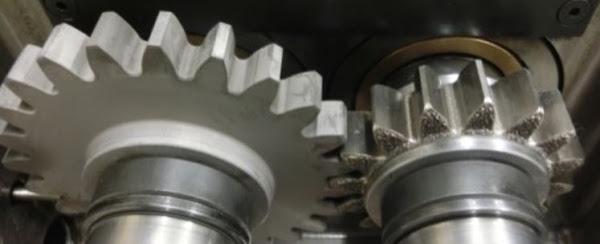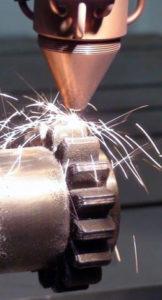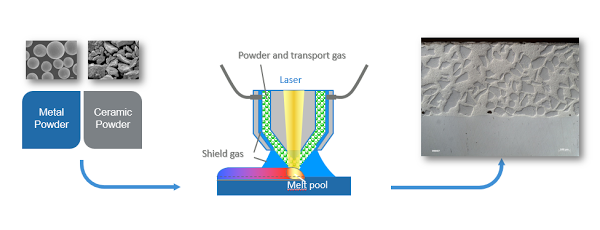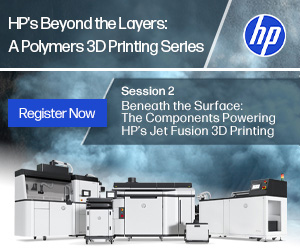VCST Looks to LCV for Help with Prototypes of Automotive Gearboxes Using Laser Cladding in 3D Printing
 Metal 3D printing is on the rise throughout the industry, and some of that is thanks to hybrid manufacturing methods, like laser cladding. This is a complex process where material, in the form of powder or wire, is fused at the height of a substrate, and the laser acts as a heat source to create a melt pool. The applied layer is metallurgically bonded to the underlying material. The technique has been used in all kinds of innovative solutions, such as a powder nozzle that can help protect sensors, and last year, Hybrid Manufacturing Technologies won a prestigious 3D printing award for its AMBIT tool-changeable laser cladding head. Global automotive OEM precision powertrain and brake component supplier VCST is working on a new concept for automotive gearboxes, and has turned to Belgium-based specialist Laser Cladding Venture (LCV) and 3D printing to keep time to market on the lower end of the scale.
Metal 3D printing is on the rise throughout the industry, and some of that is thanks to hybrid manufacturing methods, like laser cladding. This is a complex process where material, in the form of powder or wire, is fused at the height of a substrate, and the laser acts as a heat source to create a melt pool. The applied layer is metallurgically bonded to the underlying material. The technique has been used in all kinds of innovative solutions, such as a powder nozzle that can help protect sensors, and last year, Hybrid Manufacturing Technologies won a prestigious 3D printing award for its AMBIT tool-changeable laser cladding head. Global automotive OEM precision powertrain and brake component supplier VCST is working on a new concept for automotive gearboxes, and has turned to Belgium-based specialist Laser Cladding Venture (LCV) and 3D printing to keep time to market on the lower end of the scale.
 VCST has manufacturing operations in six countries. Their Sint-Truiden, Belgium office contacted LCV for assistance in manufacturing the gears for the company’s prototypes of automotive gearboxes. In order to function at the top of the pack, manufacturing prototypes need to be strong, and not so expensive that they’ll break the bank. As previously mentioned, laser cladding is moving up in the world of additive manufacturing; due to its wear protection and repair, the technology lends itself well to 3D printing. One of the big advantages of 3D printing through laser cladding is the mechanical integrity of the parts.
VCST has manufacturing operations in six countries. Their Sint-Truiden, Belgium office contacted LCV for assistance in manufacturing the gears for the company’s prototypes of automotive gearboxes. In order to function at the top of the pack, manufacturing prototypes need to be strong, and not so expensive that they’ll break the bank. As previously mentioned, laser cladding is moving up in the world of additive manufacturing; due to its wear protection and repair, the technology lends itself well to 3D printing. One of the big advantages of 3D printing through laser cladding is the mechanical integrity of the parts.
 LCV offers laser cladding as a service, and additionally helps their customers in optimizing products, and manufacturing them right in their workshop. They select the proper coating for whatever they are laser cladding, in order to make the pieces more corrosion-proof and wear-resistant. LCV prints parts with dimensions that are up to three meters, at high build rates, which enables laser cladding to be a viable alternative for manufacturing metal prototypes. According to the website, their laser cladding capabilities support and facilitate the circular economy:
LCV offers laser cladding as a service, and additionally helps their customers in optimizing products, and manufacturing them right in their workshop. They select the proper coating for whatever they are laser cladding, in order to make the pieces more corrosion-proof and wear-resistant. LCV prints parts with dimensions that are up to three meters, at high build rates, which enables laser cladding to be a viable alternative for manufacturing metal prototypes. According to the website, their laser cladding capabilities support and facilitate the circular economy:
 The laser cladding process is material and energy efficient. Since it’s an additive technique, there is no loss of material. LCV also has recycling technology for regeneration of the powder they use.
The laser cladding process is material and energy efficient. Since it’s an additive technique, there is no loss of material. LCV also has recycling technology for regeneration of the powder they use.- End-users rely on LCV for repair of critical components, so they are able to give a second life to items that would otherwise be lost.
- On a product level, LCV protects components against wear, resulting in significant life extension. For example, extrusion dies protected with LCV-CorroSlide have a 15-fold increase of lifespan.
- LCV supports the recycling industry by protecting crushers and grinders.
Tracks of molten metal are applied to a base plate, or substrate, when 3D printing by way of laser cladding. The tracks are then deposited in layers by using a laser to melt a powder, supplied either co-axially or laterally. Design solutions can be even more flexible, as LCV does not utilize the powder-bed principle found in SLM printing due to its use of multi-axis laser nozzles and substrate clamps.
 LCV delivered AE10424 gears on a cylindrical substrate, and used milling to post-process them. They also printed graded materials of the wear-resistant X42Cr13 on a tough CrMo alloy. The single-material parts built by laser “are tested on contact wear (25 million cycles at 1200 MPa) and fatigue (1 million cycles at 650 MPa).” Under a dynamic load, the laser cladded 3D printed gears had a high performance level. According to the LCV website, 3D printing with laser cladding “fits into the new era of manufacturing, based on the sustainable use of resources and materials.”
LCV delivered AE10424 gears on a cylindrical substrate, and used milling to post-process them. They also printed graded materials of the wear-resistant X42Cr13 on a tough CrMo alloy. The single-material parts built by laser “are tested on contact wear (25 million cycles at 1200 MPa) and fatigue (1 million cycles at 650 MPa).” Under a dynamic load, the laser cladded 3D printed gears had a high performance level. According to the LCV website, 3D printing with laser cladding “fits into the new era of manufacturing, based on the sustainable use of resources and materials.”
To learn more about the capabilities, applications, and benefits of laser cladding, watch LCV’s video:
Discuss in the Laser Cladding forum at 3DPB.com.
Subscribe to Our Email Newsletter
Stay up-to-date on all the latest news from the 3D printing industry and receive information and offers from third party vendors.
Print Services
Upload your 3D Models and get them printed quickly and efficiently.
You May Also Like
3D Printing News Briefs, June 4, 2025: Full-Color Slicer, Denture Implants, & More
In today’s 3D Printing News Briefs, we’ll start with some software and post-processing news, and then move on to a case report in which digital dentistry was successfully used. Read...
3D Printing News Briefs, May 31, 2025: Project Call, Consortium, Certification, & More
We’re starting with the latest America Makes Project Call in today’s 3D Printing News Briefs, and a consortium to promote the adoption of additive manufacturing has been founded in Spain....
3D Printed Microgels from Terasaki Institute Could Help Heal Tissue
In a major step forward for tissue engineering, scientists at the Terasaki Institute for Biomedical Innovation (TIBI) in Los Angeles have developed a light-based 3D printing technique that guides cells...
Insight Surgery Receives $2.5 Million Investment & FDA Clearance for 3D Printed Guides
UK-based Insight Surgery has received a $2.5 million investment, with the round led by medtech investor Nodenza Venture Partners. Insight has a workflow solution for end-to-end design and printing of...


































